United Kingdom QR Code Usage Trends 2024

The world we inhabit today is digitally-driven, and one technology that significantly contributes to our digital ecosystem is Quick Response (QR) codes. "QR codes" are two-dimensional barcodes that can store data or information. These QR codes, originally conceived in Japan, have now infiltrated various industries across the globe, including the United Kingdom. The usage of these ingenious snippets of technology has been progressively accelerating in the UK, acting as an effective bridge between the physical and digital world.
From streamlining payment processes to offering swift access to information, the versatility of QR codes renders them a potent tool for businesses, enhancing both efficiency and customer experience. An analysis of QR code usage trends in the United Kingdom reveals a remarkable upswing—an upward trajectory that's set to continue in 2024 and beyond.
This article aims to guide you through QR code usage trends in the UK, touching upon the increasing adoption rate, the digital payment landscape in 2024, real-world applications, and the future outlook.
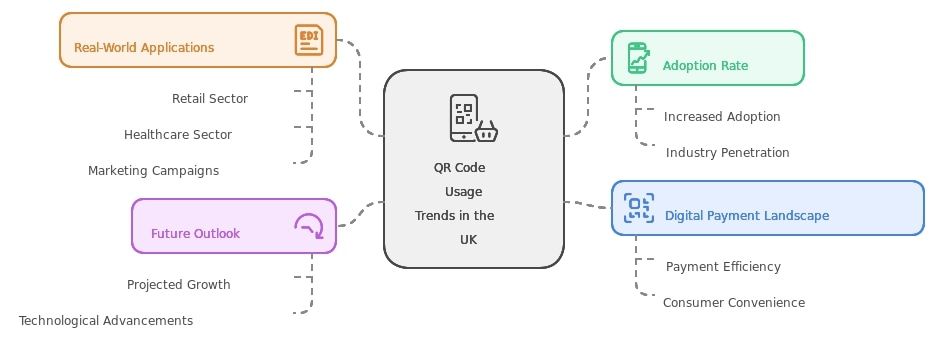
The prime focus will be on substantial data and existing statistics on QR code implementation within the UK, alongside anecdotal evidence representing their impact. Whether you're a business owner, wanting to grasp how QR codes can transform your operations or a curious reader, this article will provide a comprehensive overview of the QR code scenario in the UK.
Rising Adoption of QR Codes in the United Kingdom
The United Kingdom is amongst the pioneers when it comes to embracing emerging digital trends, and this extends to the adoption of QR codes. Over the recent years, an impressive surge in the use of QR codes has been observed in the UK, with their applications spanning diverse sectors - from retail to hospitality, and from transportation to education.
According to the market statistics, roughly 13% of all QR code users in Europe are from the UK, a figure that surpasses the global average, which hovers around 8%. The reasons behind this extensive usage boils down to the potent functionalities QR codes offer to both businesses and users and their unrivaled convenience.
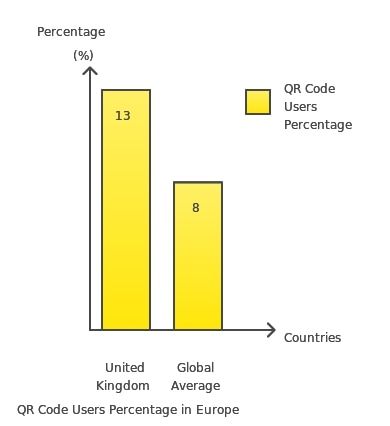
QR codes have proven to be game-changers for British businesses. They offer a dynamic and interactive means to engage customers, swiftly share information, and even facilitate seamless transactions. Let's explore some real-world instances that effectively highlight the escalating usage of QR codes in the UK:
Case Study 1 - Major Supermarkets and Retailers:
Renowned supermarkets and high-street retailers in the UK have propelled the use of QR codes for transactions. They represent the retail sector's initiative to offer an innovative, contactless, and seamless payment solution to their customers.
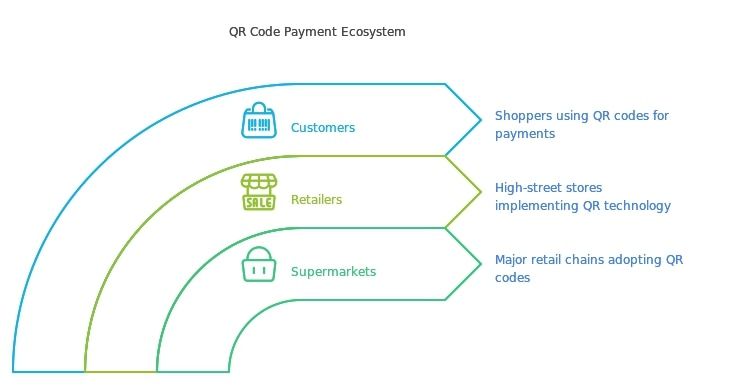
Case Study 2 - Small-Scale Enterprises:
A myriad of small enterprises in the UK have capitalized on the increasing preference for mobile commerce, offering QR payment options to their customers. Such businesses represent the growth in QR code adoption and highlight their broadening customer base.
Case Study 3 - Education Sector:
The education sector in the UK has also tapped into the potential benefits of QR codes. They are primarily used to disseminate information and grant access to digital content, ensuring a more engaging and interactive learning experience for students.
These examples reinforce the UK's progressive adoption of QR codes. The trend is expected to maintain its momentum in 2024 as a growing pool of industries realizes the advantages of this technology.
QR Code Usage for Payment Solutions in the UK
One of the key drivers of QR code adoption in the UK is their use in simplifying payment transactions. QR codes are rapidly gaining traction as a payment solution, owing to their features of convenience, efficiency, and security.
As the age of digital transformation progresses, integrated QR payment solutions are quickly becoming standard practice in the UK. Predominant supermarkets and high-street retailers are embracing QR code payments, appreciating their potential to enrich the customer experience and streamline the transaction process.
An increasing number of small businesses are also offering QR payment options for goods and services, thereby feeding the growth and popularity of mobile commerce. Furthermore, an estimated 5 million consumers in the United Kingdom currently rely on QR codes as a versatile payment method.
As of recent data, notwithstanding the impressive market growth rate of QR code payments, their utilization expands beyond the realm of just financial transactions. Businesses and organizations are discovering a myriad of innovative ways to incorporate QR codes into their operations.
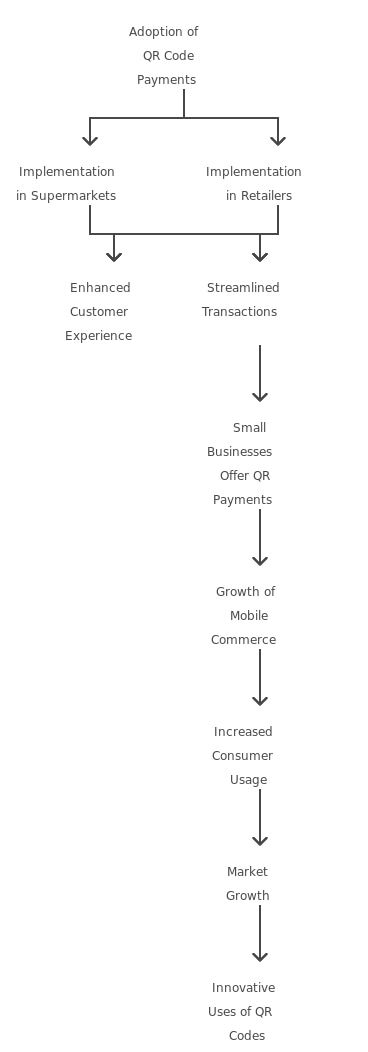
However, the financial contribution of QR codes cannot be undermined. The escalating trend of QR code payments is greatly influencing the growth of the local digital market, and based on the current trajectory, this trend shows no sign of abating anytime soon. This continued growth in QR payment adoption indicates a promising future for contactless transactions in the UK, with QR codes at the helm of this revolution.
Let's delve deeper into the prevailing figures. The already staggering number of UK residents actively using QR codes for payments is only set to rise, with an anticipated surge forecasted for 2024. Enabled by the proliferation of smartphones, the coming years are expected to witness an even wider acceptance and integration of QR code payments across the United Kingdom.
Behaviour of UK Citizens Regarding QR Codes
The behaviour and attitudes of UK citizens towards QR Codes have significantly contributed to the increasing adoption of this technology. An analysis of Google search activity can provide fascinating insights into this behaviour.
In September 2020, UK Google search activity related to QR codes reached its peak. People were increasingly curious about the uses and benefits of QR codes, which led to a spike in searches. However, the interest in the topic slightly declined by early 2023. Despite this, the prevalence and use of QR codes have remained consistently high.
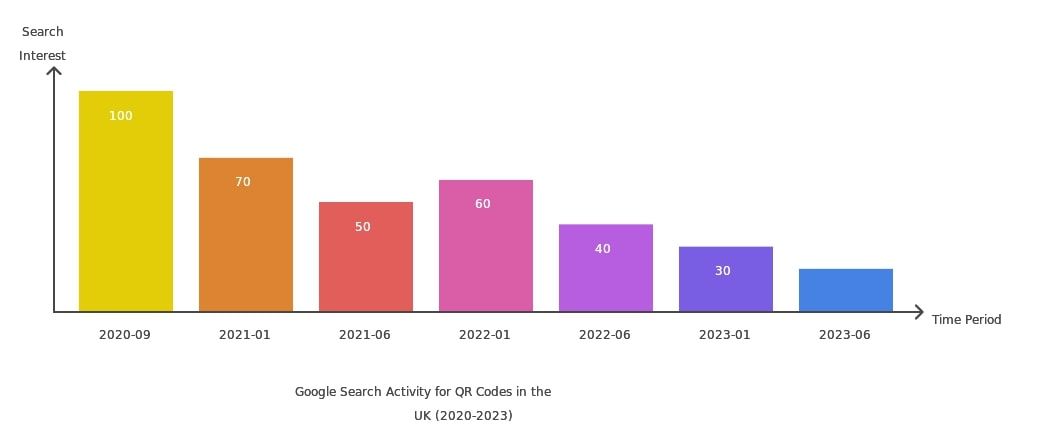
Interestingly, the coronavirus pandemic had a significant impact on QR Code usage in the UK. At the onset of the pandemic, the need for contactless transactions and information sharing grew rapidly. QR codes, being a touch-free way to transfer data, naturally became the go-to technology. This led to a surge in the adoption of QR codes across diverse sectors, especially in fields that required contactless operations.
Whether it was businesses using QR codes to share menus digitally in restaurants, government authorities using them for track and trace purposes, or individuals using them to share contact details, QR codes found widespread application during this time.

In conclusion, the behaviour of UK citizens and the influence of the pandemic have both played crucial roles in shaping the landscape of QR Code usage in the UK. While the trends may fluctuate, the evidence suggests that QR codes are here to stay.
Impact of QR Code Usage on Various Sectors
The influence of QR codes isn't confined to just one sector, but extends across a plethora of industries in the UK. Whether it’s healthcare, transportation, retail, or education, QR codes are transforming the standard procedures and customer experiences across sectors, making interactions smoother, more efficient, and data-driven.
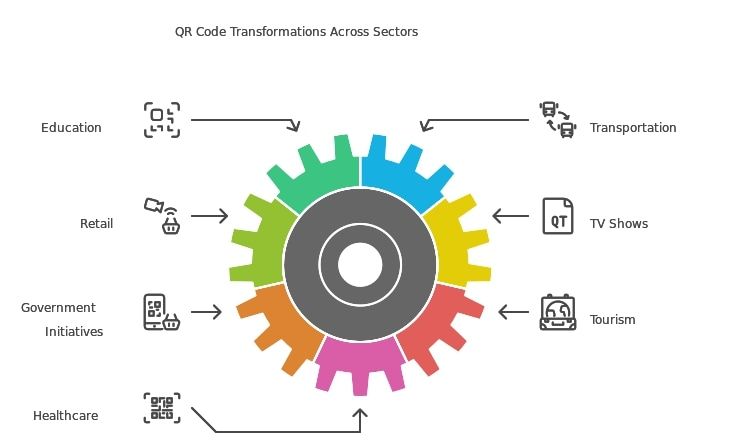
Here are real-world examples that expound on the varied applications of QR codes:
Education
Institutions like Nottingham University utilize QR codes to streamline processes, such as attendance tracking and sharing course material. It optimizes the user engagement levels and enriches the depth of interaction with students.
Transportation
To enhance passenger convenience, multiple transport services have introduced Unified QR codes, enabling passengers to avail multiple transportation services using a singular ticket. This allows for unhindered travel and a seamless user experience.
Retail
Famously, UK department store John Lewis utilized QR codes to blend their customers' online and offline retail experiences. For instance, a QR-driven window display allowed shoppers to purchase featured items using their mobile devices with QR codes.
TV Shows
BBC has used QR codes to provide viewers with additional, real-time content. The cooking show 'The Good Cook’ featured QR codes that directed viewers to recipes and ingredient details.
Government Initiatives
In a bid to foster competition within the energy sector, the UK government introduced QR codes on energy bills. This allowed customers to easily compare prices between providers, fostering transparency and customer empowerment.
Tourism
Tourist destinations in Cornwall used large QR codes to encourage and facilitate conservation donations, seamlessly integrating the need for preservation with the visitor experience.
Healthcare
Healthcare company Bayer Consumer Health UK made access to treatment more inclusive by debuting QR codes to assist individuals who are blind or partially sighted.
Each of these examples manifest the transformative potential of QR codes and their cross-sector impact. With the rising adoption of QR codes across these sectors, it's clear that QR technology will continue to shape the landscape of communication, commerce, and beyond in the UK.
Digital Payment Statistics and Trends in the UK
The digital payment landscape in the UK has been evolving rapidly, with QR code payments emerging as a notable trend.
Current Trends
Currently, digital payments in the UK primarily revolve around debit cards and increasingly, mobile wallets. In a survey conducted in 2022 regarding payment brand usage in stores or restaurants via mobile devices, nearly seven out of ten respondents cited Apple Pay.
Despite the rise of digital payments, cards, powered by the widespread integration of contactless technology, maintain their supremacy in both point-of-sale (POS) and e-commerce transactions in the UK. This dominance is especially evident in POS payments.
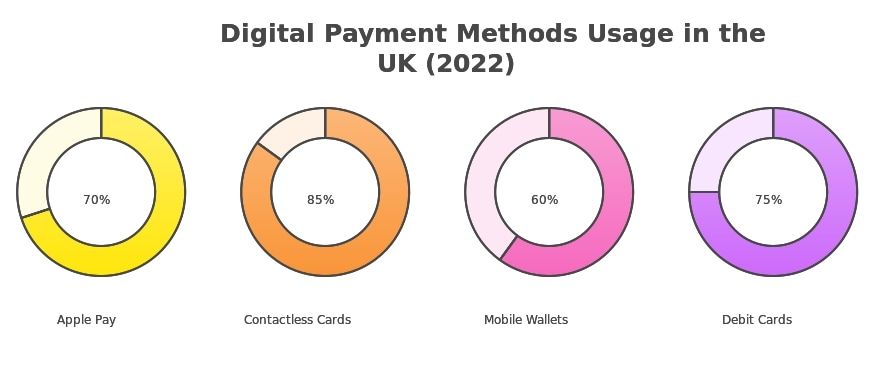
Future Projections
Looking into the future, predictions suggest a slight reduction in the number of credit cards in circulation between 2022 and 2028 — a drop of a modest 20,000 cards. In contrast, a growth estimation of 6.4 percent in the usage of debit cards in the UK by 2028 is anticipated. This forecast indicates the increasing acceptance of digital payment solutions coupled with a gradual shift away from traditional physical payment modes.
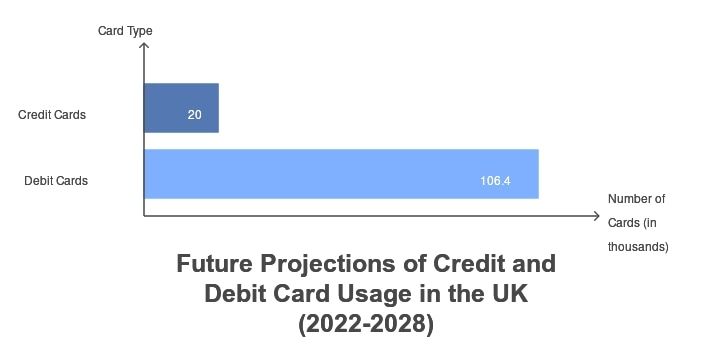
Modernizing the UK Payment Infrastructure
In line with the trend of digitalization, the UK is implementing several initiatives to modernize its payment infrastructure integrating new technologies. A key initiative is the New Payments Architecture (NPA), set to replace the existing Faster Payments and BACS clearing systems. This is projected to consolidate them into a single central payments infrastructure for both retail and wholesale transactions by around 2030.
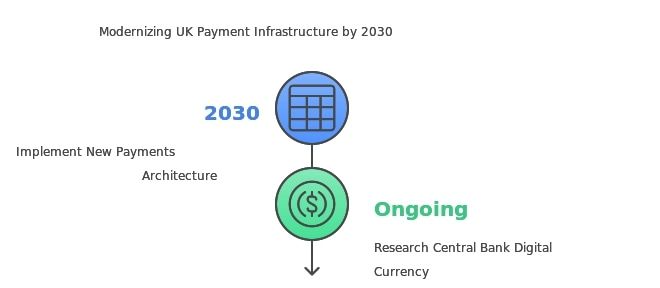
Furthermore, significant efforts are well underway in researching Central Bank Digital Currency (CBDC). The UK is leading in exploring the potential application of CBDCs in cross-border interbank payments.
The Rise of BNPL in the UK Retail Landscape
Besides these trends, the Buy Now, Pay Later (BNPL) sector is also witnessing considerable growth in the UK. BNPL options offer customers the flexibility to make purchases promptly and pay for them gradually over time. It's predicted that by 2024, approximately seven out of ten UK retailers will incorporate BNPL options into their online platforms.
In summary, the UK digital payment landscape is experiencing dynamic changes, with QR codes being a prominent part of this transformation. As we forge ahead into 2024, advancements and adaptations in digital payments continue to gain momentum, promising exciting developments in the years ahead.
Future Perspectives of QR Code Usage
Building on the current trends and developments, future perspectives for QR code usage in the UK project significant growth and continuing relevance. As evident, the digital transformation of the UK economy is well underway, with QR codes playing a vital role in this evolution.
Steady Growth with Potential Spikes
The steady rise in QR code adoption across diverse sectors in the UK indicates a promising landscape that’s ripe for further expansion. As businesses continue to recognize the potential of QR codes in enhancing customer experience, promoting efficiency, and fostering business growth, their use is likely to proliferate.
Despite the dip in Google search trends for QR codes by early 2023, the consistent usage across various sectors presents a conflicting scenario — one that predicts growth rather than stagnation for QR codes in the UK.
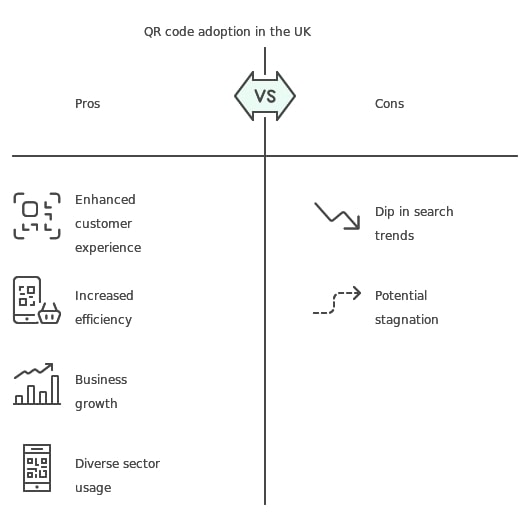
Potential Contribution to Digital Payments
Within the evolving digital payment landscape, QR codes are forecasted to become a significant player. As digital payment trends veer towards contactless transactions, QR codes stand at the forefront of promoting efficient, secure, and rapid payments. In-line with the 2028 projection for digital payments, QR codes are expected to contribute significantly to this momentum.
In light of the potential for QR code payments, organizations are likely to invest in tailoring QR code marketing strategies. This could see QR codes weave into the fabric of daily life- beyond just payment transactions.
The Way Forward
From streaming services to takeaway meals, and shopping to entertainment venues, QR codes can transform several aspects of day-to-day life. As this technological tool becomes increasingly mainstream in the UK, we can expect the focus to shift from adoption to optimization, whereby businesses will strive to utilize QR codes in innovative, efficient, and user-focused ways.
The trajectory for QR code usage in the UK points towards sustained growth, with room for potential spikes driven by tech developments, discoveries of new applications, and wider public acceptance. It's crystal clear that QR codes are an integral part of the UK's digital future.

Conclusion
In conclusion, the United Kingdom's QR code usage trends reflect a compelling narrative of digital transformation. QR codes are not just surviving but thriving in the UK, largely thanks to their diverse applications, ease of use, and the surge in mobile phone usage.
To summarize, this article explored various aspects of QR code usage in the UK, from its rising adoption and diversifying applications to the reshaping of the digital payment landscape and future projections.
We touched upon the staggering adoption rates in the UK, far surpassing the rates in many European countries. The exploration into how sectors like education, retail, and transportation are utilizing QR codes to optimize operations and improve customer experiences shed light on their widespread applications.
The trends within the digital payment niche in the UK indicate a shift towards contactless transactions and mobile wallets, a shift being significantly powered by breakthroughs like QR codes. Recent initiatives, like CBDCs and NPA, further evidence the UK's resolve to stay at the forefront of the digital revolution.
Looking ahead, the trajectory for QR codes in the UK points to sustained growth, with exciting developments forecasted for 2024 and beyond. The QR code, originally intended as a tool for tracking car manufacture, has now embedded itself into everyday life.
In the years to come, the reach of QR codes is set to extend further still, drastically reshaping numerous sectors within the UK market. As we navigate this digital evolution, one thing is clear — QR codes will continue to be significant actors in shaping the future of commerce, communication, and beyond in the UK.
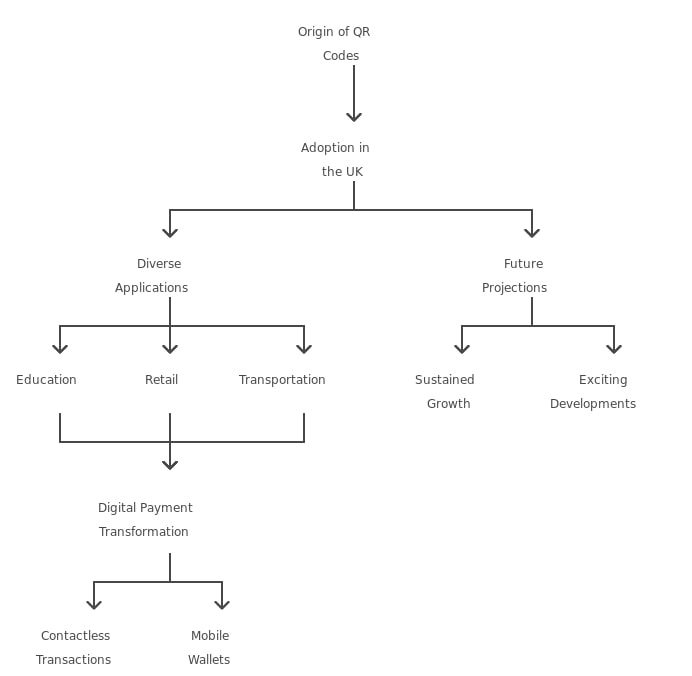
Frequently Asked Questions (FAQs)
1. What is a QR Code?
A QR code (Quick Response code) is a type of 2D barcode that can store information and can be scanned and read by smartphones or QR readers.
2. Why are QR Codes gaining popularity in the UK?
QR codes are convenient, versatile, and efficient. They fast-track transactions, provide easy access to information, and enhance customer experiences. Their extensive applications in various sectors including retail, education, transportation, and more, contribute to their growing popularity in the UK.
3. What influence did the pandemic have on QR Code usage in the UK?
The pandemic exponentially increased the need for contactless operations. QR Codes, being touch-free ways to transfer data, naturally saw a surge in usage. Businesses used QR codes to share menus digitally, authorities used them for track and trace purposes, and individuals used them to share contact details, driving up the demand for QR codes significantly.
4. How are QR codes being used in digital payments in the UK?
QR codes are being widely used for contactless transactions in the UK. Supermarkets, high-street retailers, and small-scale enterprises are offering QR code payments, boosting the trend of mobile commerce.
5. What is the future of QR Codes in the UK?
As businesses continue to recognize the potential of QR codes in enhancing operations and customer experiences, their use is likely to proliferate. The possibility of using QR codes for various purposes — from payments and information sharing to promotional activities — is bound to cause sustained growth in QR code usage in the UK.
Check other articles you may want to look:
QR Code Statistics 2024: Global Adoption & Use Cases (Nov Updated)

